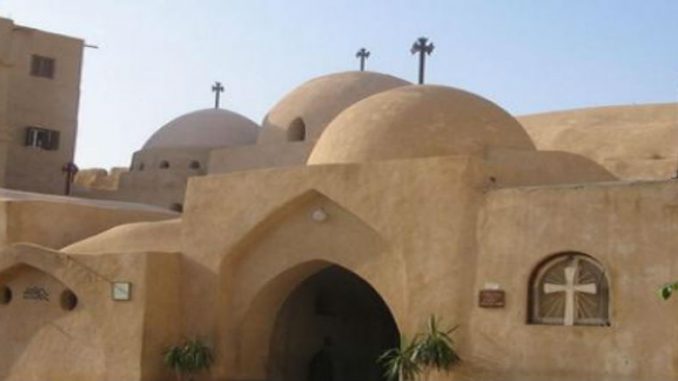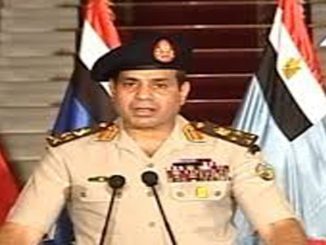Prosecutors ordered a recently defrocked monk to be detained for four days pending an investigation into his alleged involvement in the death of the bishop of a prominent monastery in the desert northwest of Cairo, according to Egypt’s state news agency.
The defrocked monk, identified by his monastic name of Isaiah, confessed to collaborating with others to kill Bishop Epiphanius, abbot of St. Macarius Monastery, prosecutors said.
Isaiah’s lawyer withdrew from the case and ceased defending him, the state-run MENA reported. It remains unclear whether another lawyer will be assigned to the case.
The decision to strip Isaiah of his monkhood came August 5, a week after the abbot’s death. The Coptic Orthodox Church dismissed any connection to the Epiphanius’ death, however, saying the decision was made based on “strictly monastic reasons.”
The church announced the defrocking of Makari for “committing inappropriate behavior that contradicts monastic behavior,” yet no further details were released.
On August 6, a young monk called Fatlaous al-Makari slit his wrist and jumped off a high building also in the same monastery and was taken to the hospital.
The Coptic Orthodox Church also issued a number of decrees concerning monastic life. These included giving monks one month to close all their accounts on social networking websites—the Pope starting by closing his Facebook page—and not accepting new monks for one year in all monasteries across the nation.
The church also warned monks of appearing in the media, being involved in any financial interactions or taking part in any projects without the prior approval of their respective monasteries, getting out of their monasteries without reason, or receiving visitors without permission.
In the early hours of July 29, Bishop Epiphanius, Abbot of Saint Macarius the Great Monastery in Wadi al-Natroun, was found dead in a hallway inside the monastery.
The 64-year-old bishop was lying in a pool of blood and investigations revealed he was hit on the head with a heavy object.
Former Conflicts within the Coptic Church
According to analysts, questions about a conflict within the Coptic Orthodox Church seem rather inevitable as it hard to dismiss a connection between these incidents. It is worth to mention the past conflicts within the Coptic Church, in which the monastery of Saint Macarius the Great featured prominently, and the current developments.
In fact, the latest incidents bring back to the surface the long disagreement between the late Pope Shenouda III and Father Matta al-Meskin, the late abbot of the monastery, according to Journalist Maged Atef comments on the incidents.
“The two men adopted different views on the role of the church. While Shenouda worked on consolidating ties between the church and the state, al-Meskin believed that the church’s role should only be spiritual,” he wrote.
“Al-Meskin was also more open to reconciliation with other sects than Shenouda who was quite hostile to the West, hence its churches, and was more affected by Gamal Abdel Nasser’s nationalist discourse.”
While the conflict started at an earlier stage, it escalated remarkably after Shenouda had taken office as the Patriarch and started launching a campaign against al-Meskin.
“This campaign, carried out by Shenouda’s supporters, focused on accusing al-Meskin of heresy and discrediting all the studies he conducted on Coptic Orthodoxy and monastic life,” Atef explained, adding that al-Meskin’s books were banned from all libraries affiliated to the church.
Matta al-Meskin, on the other hand, retired to the monastery and there attracted a large number of disciples who subscribed to his views. “This drove Shenouda to send more of his supporters to the monastery, which therefore became the center of the conflict.”
It is noteworthy that Bishop Epiphanius was among the supporters of Matta al-Meskin while both Isaiah al-Makari and Fatlaous al-Makari belong to the more conservative school led by Pope Shenouda.
The Murder of Bishop Epiphanius: The Revival of Conflicts in the Monastery
According to journalist Tamer Hendawi, the circumstances surrounding the murder of Bishop Epiphanius link it to the conflicts within the monastery. “The bishop was killed on his way from his room to the church, which makes it more likely that the killer is from inside the monastery,” he wrote.
Hendawi added that in monasteries only monks are allowed in and a very limited number of workers. “As for visits, they are preplanned and are not frequent.”
Hendawi added that for years that monastery has been divided between supporters of two different schools and the disputes escalated in the years between the death of Matta al-Meskin in 2006 and the death of Shenouda in 2012.
“When Pope Shenouda visited the monastery in 2009, then Abbot Bishop Mikhail submitted his resignation. During this visit, Pope Shenouda made the monks wear a coif and Matta al-Meskin was against that and spent all his monastic life without wearing one.”
Hendawi notes that the escalation of tension in the monastery drove Bishop to go back to managing the monastery. “Yet as soon as Pope Tawadros II took office, Mikhail asked to be relieved of his duties and this is when Bishop Epiphanius was chosen.”
Hendawi also points out the decision to close all monks’ accounts on social media is another proof that the conflict is related to recent developments. “Closing those accounts was obviously a means of avoiding further tension between the two camps in the monastery and preventing this tension from coming out to the public.”
Writer Shadi Luis notes that the monastery of Saint Macarius the Great has always been a symbol of rebelling against the authorities since Byzantine times and argues that while there is no proof that the latest incidents are linked to past disputes, they at least highlight the fact that the monastery of Saint Macarius the Great is still a center of such conflict.
“And regardless of what investigations would prove, the church is likely to use the murder as a pretext for subjugating all forms of rebellion and for which the monastery has for years been a symbol,” he wrote, adding that the monastery, on the other hand, will try as hard as it can to maintain the independence it managed to gain throughout the years.
Despite the fact that Pope Tawadros II is considered a reformist who to a great extent subscribes to many of Matta al-Meskin’s ideas, Luis argues that he is more likely to continue the work of his predecessors as far as centralizing the power of the Coptic Church is concerned.
“The pope will work on becoming the sole representative of the Copts on both the spiritual and political levels and will be supported in that by the state as well as by the general political atmosphere,” he added.
“If this happens, it will put an end to a history of rebellion within Coptic Christianity, one that actually goes back to the fourth century AD and that was always epitomized by the monastery of Saint Macarius the Great.”


